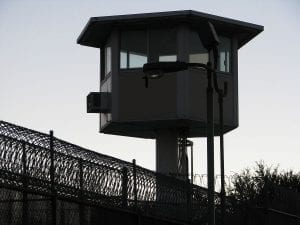An Alabama death row inmate has asked that a court prohibit the state from continuing to use nitrogen gas in any further executions.
An Alabama death row inmate has filed a federal lawsuit challenging the constitutionality of recently-approved nitrogen gas executions, claiming that the first person put to death under the new method shook violently for several minutes in “a human experiment that officials botched miserably.”
According to The Associated Press, the lawsuit was filed earlier this week in a federal court. In it, plaintiff David Wilson claims that the January execution of Kenneth Eugene Smith was so torturous that it “cannot be allowed to be repeated.” Wilson’s complaint cites eyewitness accounts, which suggest that Smith spent minutes shaking and convulsing before dying—apparently contradicting the state’s suggestion that nitrogen would provide a quick and reasonably humane death.
“The results of the first human experiment are now in, and they demonstrate that nitrogen gas asphyxiation is neither quick nor painless, but agonizing and painful,” attorney Bernard E. Harcourt wrote in the complaint.
The lawsuit seeks a judgment finding that nitrogen gas asphyxiation violates death row prisoners’ constitutional protections against cruel and unusual punishment.
Alabama, adds The Associated Press, is among just three states that permits the use of nitrogen gas in executions. And, in January, it became the first to ever use its nitrogen stock for its intended purpose.

Executions conducted with nitrogen gas entail fitting a respirator over the face of the inmate.
Once the respiratory is fitted tightly, nitrogen gas is pumped in, causing the prisoner to die from rapid oxygen deprivation.
Last month, the U.S. Supreme Court agreed to let Smith’s execution by nitrogen gas proceed as planned. But Wilson and his attorneys are now asking that the practice be discontinued, citing accounts of Smith’s death run counter to Alabama’s claims that nitrogen asphyxiation can cause death “within seconds.”
“The gas appeared to start flowing at approximately 7:58 p.m.,” AL.com wrote in its coverage of the execution. “Smith visibly shook and writhed against the gurney for around two minutes. His arms thrashed against the restraints.”
“He breathed heavily, slightly gasping, for approximately seven more minutes,” AL.com said. “At one point, his wife cried out.”
Smith, AL.com says, appears to have remained alive for at least 10 minutes, with the curtains drawing on the execution at 8:15pm.
“In stark contrast to the Attorney General’s representations, the five media witnesses chosen by the Alabama Department of Corrections and present at Mr. Smith’s execution recounted a prolonged period of consciousness marked by shaking, struggling, and writhing by Mr. Smith for several minutes after the nitrogen gas started flowing,” the lawsuit alleges.
However, corrections officials have since said that the state expected inmates being executed to make “involuntary movements” in the period between losing consciousness and death.
“That was all expected,” Corrections Commissioner John Q. Hamm said, “and was in the side effects that we’ve seen or researched on nitrogen hypoxia.”
Sources
Alabama death row inmate files lawsuit after the state’s first nitrogen gas execution
Alabama executes Kenneth Eugene Smith by new nitrogen gas method for 1988 murder of pastor’s wife
First nitrogen execution was a ‘botched’ human experiment, Alabama lawsuit alleges


Join the conversation!